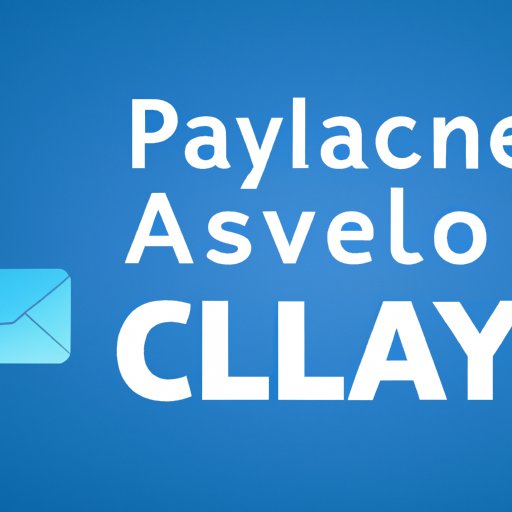
Introduction
PayPal is one of the most commonly used payment methods for online purchases. While it is a convenient way to send and receive money, there are times when you may need to cancel a payment. This could be due to a variety of reasons, such as an error in the payment amount or a change in plans. Whatever the reason may be, it is important to know how to cancel a PayPal payment.
In this article, we will provide you with a step-by-step guide to cancelling a PayPal payment, dos and don’ts to follow, and tips on how to request a refund. We will also discuss common scenarios where you may need to cancel a payment and what you need to know before making a purchase.
How to Cancel a PayPal Payment: Step by Step Guide
If you need to cancel a PayPal payment, the process is fairly straightforward. The steps below will guide you through the process:
- Log in to your PayPal account.
- Click “Activity” at the top of the page to view your recent transactions.
- Find the payment you want to cancel and click on it.
- Click “Cancel” under the “Order status/Actions” heading.
- Follow the on-screen instructions to confirm the cancellation.
It is important to note that if the payment has already been completed, you will not be able to cancel it. In this case, you will need to request a refund from the seller.
If you are unsure about whether or not the payment has been completed, check your bank statement or PayPal balance. If the amount has been deducted, the payment has been completed.
To ensure a successful cancellation, be sure to check that the payment has not been completed before initiating the cancellation process. If the payment has been completed, contact the recipient and request a refund.
The Dos and Don’ts of Cancelling a PayPal Payment
When it comes to cancelling a PayPal payment, there are certain dos and don’ts to follow to ensure a hassle-free experience. Here are some guidelines to follow:
Dos:
- Double-check that the payment has not been completed before cancelling.
- Reach out to the recipient if the payment has been completed for a refund.
- Use the step-by-step guide provided by PayPal to cancel the payment.
- Keep a record of the cancellation confirmation for future reference.
Don’ts:
- Cancel a payment if it has already been completed. You will need to request a refund in this case instead.
- Ignore the confirmation page after cancelling a payment. Take note of the confirmation for future reference.
- Wait too long to cancel a payment. If the payment has been completed, it may become more difficult to obtain a refund.
Understanding PayPal’s Refund Policy: Cancel or Request a Payment Reversal?
It is important to understand the difference between cancelling and requesting a payment reversal. Cancelling a payment means that the payment has not been completed and no funds have been transferred. Requesting a payment reversal means that the payment has already been completed and you are asking for a refund from the recipient.
If you cancel a payment, the recipient will not receive any money and the funds will be refunded to your PayPal account. If a payment has been completed, you will need to request a refund from the recipient. PayPal’s refund policy states that the recipient has 180 days to issue a refund. If this time has passed, you can open a dispute through PayPal’s Resolution Center.
If you need to request a refund, navigate to the transaction in your PayPal account and click “Dispute a transaction” under the “Help and Contact” section. From there, you can select “Item dispute” or “Unauthorized transaction” and follow the on-screen instructions to begin the dispute process.
Common Scenarios Where You May Need to Cancel a PayPal Payment
There are various scenarios where you may need to cancel a PayPal payment. Here are some examples:
Change of mind
If you accidentally sent a payment or changed your mind about a purchase, you may need to cancel the payment.
Payment error
If you made an error with the payment amount, it may be necessary to cancel the payment and start again with the correct amount.
Transaction issue
If there is an issue with the transaction or the recipient is unable to fulfill the order, you may need to cancel the payment.
In any of these situations, it is important to act quickly to prevent any further issues from arising.
PayPal Payment Cancellation: What You Need to Know Before Making a Purchase
Before making a purchase with PayPal, there are a few things to consider to avoid the need for payment cancellation. Here are some tips:
Check the seller’s refund policy
Before making a purchase, check the seller’s refund policy to ensure that you are aware of their terms and conditions. This can help you avoid any misunderstandings or issues.
Double-check the payment details
Be sure to double-check the payment details before confirming the transaction. This can help prevent errors or issues that may require payment cancellation.
Be wary of red flags
If there are any red flags with the seller or the transaction, such as incorrect details or suspicious behavior, it may be best to cancel the payment and look for an alternative option.
Conclusion
Cancelling a PayPal payment may seem like a daunting task, but it is actually quite simple as long as you follow the steps provided by PayPal. Remember to double-check that the payment has not been completed and to reach out to the recipient for a refund if necessary.
By following the dos and don’ts, understanding PayPal’s refund policy, and being aware of common scenarios where you may need to cancel a payment, you can ensure a smooth and stress-free experience when using PayPal.





